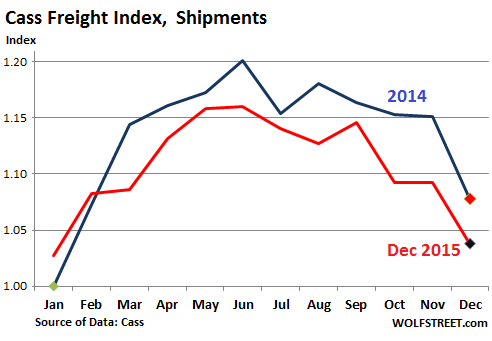As much as we would have liked to, the Dow Transportation Average wasn’t kidding. It has plunged 27% since its high on December 5, 2014. Nearly two-thirds of that plunge came over the past two months. Transportation companies are singing the blues. Railroads, trucking, air freight….
Union Pacific, the largest US railroad, reported awful fourth-quarter earnings Thursday evening. Operating revenues plummeted 15% year over year, and net income dropped 22%.
It was broad-based: The only category where revenues rose was
automotive (+1%). Otherwise, revenues fell: Chemicals (-7%),
Agricultural Products (-12%), Intermodal containers (-14%), Industrial
Products (-23%), and Coal (-31%). Shipment of crude plunged 42%.So Union Pacific did what American companies do best: it laid off 3,900 people last year.
This is what CEO Lance Fritz told Reuters about the American consumer: “What’s causing us some concern is it’s hard to figure out where the consumer is at.”
Consumers were sending mixed signals. Spending is shifting from retail of goods toward services. People were buying automobiles, and auto shipments rose in the quarter. And unemployment numbers looked good, he said, but labor participation “is lackluster and consumers just don’t seem to be showing up to purchase goods and services.”
And another disappointment about consumer behavior, according to Fritz: “There was a widespread belief that consumers would turn the savings from low fuel into spending, and we haven’t seen that so much.”
Canadian Pacific, which is trying to buy US rival Norfolk Southern in a deal that is vigorously contested by other railroads, reported a 4% drop in fourth-quarter revenues and a 29% drop in net income. Among its biggest decliners: crude-oil shipments (-17%) and consumer-products shipments (-24%). It garnished the report with an announcement of up to 1,000 layoffs.
CSX, in its earnings release earlier in January, reported a revenue decline of 7% for the year.
On January 7, the Association of American Railroads (AAR) reported on the deterioration in shipment volumes late last year. In December, total volume dropped 8.9% year over year: intermodal containers and trailers, which had been holding up for much of the year, edged down 0.7%; and carloads (bulk commodities, autos, and the like) plunged 15.6% [read… Rail Shipments Plummet to Recessionary Levels].
This was echoed by the Cass Freight Index, which tracks freight transactions by “hundreds of large shippers,” regardless of mode of transportation, including by truck and rail. It does not cover bulk commodities, but is focused on consumer packaged goods, food, automotive, chemical, OEM, heavy equipment, and retail.
In December, shipment volume fell 3.7% year over year. Note how the index for 2015 (red line) has been lower that in 2014 (blue line) every month, with the exception of January and February:

The Cass report added some bitter morsels:
In retrospect, 2015 did not even begin to reach the heights we reached in 2014. By the end of 2015, both shipment volume and expenditures fell back to 2013 levels.The never-dying meme of gas savings going into brick-and-mortar retail! Instead it’s going into housing costs, healthcare, education, etc., which have risen relentlessly, and for many people have soared.
High inventories are a problem for retailers, wholesalers, and manufacturers, so a majority of goods were discounted.
Export demand was way off in 2015 because of global economic conditions and the relative strength of the U.S. dollar.
Consumers remained cautious about extending any new credit for holiday purchases, waiting for the best bargains. Retailers had hoped the extra cash generated by still-falling gas prices would boost sales, but instead consumers increased their visits to restaurants and similar businesses.
Boeing chimed in last night: It said it would cut production of its 747-8 freighter program “to match supply with near-term demand in the cargo market.”
While global air passenger traffic was still growing, it said, “the air cargo market recovery that began in late 2013 has stalled in recent months and slowed demand for the 747-8 Freighter.” It cited industry data that showed that air freight in November contracted in volume by 1.2% year over year.
This threat of a “transportation recession” is the expansion a theme we’ve been following for a while and that Moody’s called the threat of an “industrial recession”:
Slowing demand leads companies to delay investment and cut costs to protect their profits. But these measures create a cycle that further weakens demand, leading to recessionary conditions that could keep the industry from rebounding as quickly as it did in the wake of the Great Recession.What’s amiss in the US goods-based economy? High inventories and sluggish demand.
As the Dow Jones Transportation Average has been pointing out, these conditions are now rattling the broader transportation sector to add one more sub-recession to the growing list that already includes the “earnings recession” and an “industrial recession,” both of which are linked to broad economic recessions. The only exceptions occurred in the early 1950s. Read… This is Where Industrial Production Normally Meets a Recessio
No comments:
Post a Comment